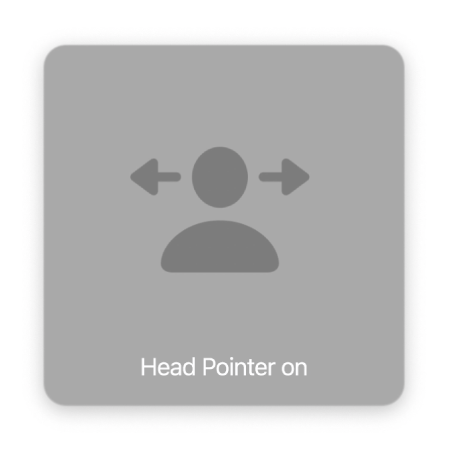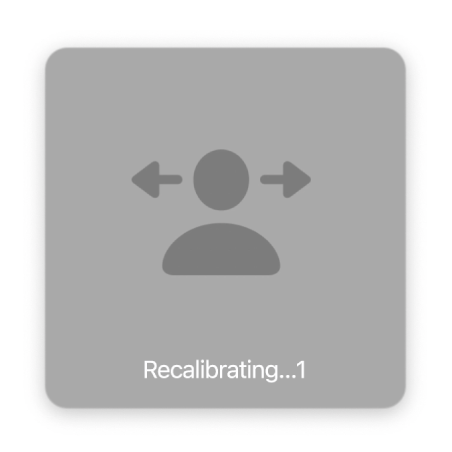
Move the pointer using head pointer on Mac
If you have difficulty using a mouse or trackpad, you can use head pointer on your Mac. Head pointer lets you move the pointer on the screen using the movement of your face or head, as detected by the camera that’s built into or connected to your Mac. For example, if you move your head to the left, the pointer follows in that direction on the screen.
Turn on and customise head pointer
On your Mac, choose Apple menu

 , click Pointer Control, then click Alternate Control Methods.
, click Pointer Control, then click Alternate Control Methods. Select Enable head pointer.
An alert is briefly displayed to indicate head pointer is on.

Click Options.
You can set options to specify how the pointer moves, how fast it moves, which camera to use, and switches to use for actions such as pausing, resuming and recalibrating head pointer. For information about the options, click the Help button
 in the lower-right corner of the Alternative Control Methods pane.
in the lower-right corner of the Alternative Control Methods pane.
Use head pointer
On your Mac, make sure the camera you selected in head pointer options is on.
If you’re using your Mac computer’s built-in camera, a green light beside the camera (at the top of the display) glows to indicate the camera is on.
Centre yourself in front of the screen, making sure your head isn’t too far to the left or right.
Depending on the options you set for how the pointer moves, either turn your face away from the centre of the screen or move your head in the direction you want the pointer to move; you don’t need to exaggerate movements or move your shoulders or body.
For example, to move the pointer to the right, turn your face towards the right edge of the screen or move your head to the right. The farther you turn your face to the right or the faster you move your head, the faster the pointer moves across the screen.
To stop the pointer, either turn your face to the centre of the screen or stop moving your head.
When the pointer is at the location you want, you can perform left-click, right-click, double-click or drag-and-drop actions using Mouse Keys, switches (such as keyboard keys, assistive switches or facial expressions) or Voice Control.
If you specified a switch to pause or resume head pointer in head pointer options, use the switch to pause it at any time. For example, if you specified the keyboard key “z” as the switch, use the key to pause head pointer when you’re away from your Mac for a while.
Troubleshoot head pointer
If you can’t move the pointer the way you expected using head pointer on your Mac, try these suggestions.
If head pointer doesn’t seem to work: Make sure it’s enabled in Alternative Control Methods preferences. If it’s enabled but still isn’t working, make sure it’s not paused. Also check that the camera you’re using is turned on, facing you, and unobstructed.
If the pointer doesn’t move: If you or someone else is moving the pointer using a mouse or trackpad, head pointer pauses; when you stop using the mouse or trackpad, head pointer automatically resumes.
If the pointer moves erratically: Adjust the lighting around you to ensure your face and head are clearly detected by your camera.
If the pointer moves too far or not far enough: Adjust the pointer speed you set for head pointer. The lower the speed, the less distance the pointer moves when you move your face or head; the higher the speed, the farther the pointer moves.
If the pointer moves too slowly or quickly: Turn your face or move your head more quickly or more slowly.
If the pointer seems stuck on an edge of the screen: Make sure you’re centred in front of the screen and that your head isn’t too far to the left or right. You may need to adjust the position of your display or camera.
If a message appears that head pointer failed: It’s possible the lighting is too bright or dark, that you’re too close to or far from the camera, or not centred in front of the screen. Try adjusting the lighting or repositioning yourself in front of your display or camera.
If the pointer is difficult to locate on the screen: Try recalibrating head pointer.
Recalibrate head pointer
You can recalibrate head pointer to reposition the pointer in the middle of the screen and reset your default face or head position, depending on the option you set to control how the pointer moves.
On your Mac, choose Apple menu

 , click Pointer Control, then click Alternate Control Methods.
, click Pointer Control, then click Alternate Control Methods. Select Enable head pointer, then click Options.
Click Actions, select the tickbox to recalibrate head pointer, then click Assign to choose a switch to perform the action.
Adjust the position of your face or head, then use your switch to start recalibration.
The onscreen countdown is displayed and counts down from 3. When the countdown is at 1, refrain from moving so you’re still during recalibration.

When the onscreen countdown disappears, head pointer is recalibrated and you can continue to use head pointer.
Repeat steps 4 and 5 anytime you want to recalibrate head pointer.
To quickly turn head pointer on or off using the Accessibility Shortcuts panel, press Option-Command-F5 (or if your Mac or Magic Keyboard has Touch ID, quickly press Touch ID three times).
To specify which options are available in the panel, choose Apple menu > System Preferences, click Accessibility, then click Shortcut.